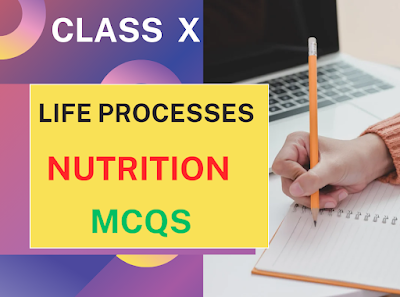1. What is the function of hydrochloric acid in the stomach?
A) Protection of stomach lining
B) Emulsification of fats
C) Activation of pepsin
D) Neutralization of enzymes
2. Which of the following organisms are autotrophs?
A) Animals
B) Green plants
C) Fungi
D) Virus
3. Parasitic mode of nutrition is present in
A) Cuscuta
B) Tapeworm
C) Leeches
D) All of the above
4. Which organ secretes bile juice to emulsify fats in the small intestine?
A) Liver
B) Gallbladder
C) Pancreas
D) Stomach
5. What is the stored form of carbohydrates in plants?
A) Glucose
B) Sucrose
C) Starch
D) Fructose
6. What is the role of stomata in photosynthesis?
A) Absorption of water
B) Exchange of gases
C) Absorption of sunlight
D) Storage of nutrients
7. What organelle in plant cells contains chlorophyll?
A) Nucleus
B) Golgi apparatus
C) Chloroplast
D) Endoplasmic reticulum
8. Which enzyme present in saliva helps in the breakdown of starch?
A) Pepsin
B) Trypsin
C) Lipase
D) Salivary amylase
9. What is the main function of chlorophyll in photosynthesis?
A) Absorption of light energy
B) Production of carbohydrates
C) Splitting of water molecules
D) Reduction of carbon dioxide
10. Where does complete digestion of carbohydrates, proteins, and fats occur?
A) Stomach
B) Large intestine
C) Small intestine
D) Liver
11. Assertion (A): Photosynthesis occurs only during the day.
Reason (R): Desert plants take up carbon dioxide at night for photosynthesis.
A) Both A and R are true, and R is the correct explanation of A.
B) Both A and R are true, but R is not the correct explanation of A.
C) A is true, but R is false.
D) A is false, but R is true.
12. Assertion (A): Autotrophs are essential for the survival of heterotrophs.
Reason (R): Heterotrophs directly obtain energy from sunlight.
A) Both A and R are true, and R is the correct explanation of A.
B) Both A and R are true, but R is not the correct explanation of A.
C) A is true, but R is false.
D) A is false, but R is true.
13. Match the following terms with their descriptions:
i) Stomata A) Absorption of nutrients
ii) Heterotrophs B) Food making process in plants
iii) Villi C) Tiny pores on leaf surfaces
iv) Photosynthesis D) Finger like projections in the small intestine
A) i-C, ii-A, iii-D, iv-B
B) i-A, ii-C, iii-B, iv-D
C) i-B, ii-D, iii-C, iv-A
D) i-D, ii-B, iii-A, iv-C
14. Assertion: Photosynthesis is the process by which autotrophs convert carbon dioxide and
water into carbohydrates.
Reason: Carbohydrates produced during photosynthesis are used as an energy source for
plants.
A) Both assertion and reason are true, and the reason is the correct explanation of the
assertion.
B) Both assertion and reason are true, but the reason is NOT the correct explanation of the
assertion.
C) Assertion is true, but the reason is false.
D) Assertion is false, but the reason is true.
15. Which of the following is true about heterotrophic nutrition?
A) Organisms produce their own food
B) Complex substances are broken down externally
C) Energy is obtained from inorganic sources
D) Examples include green plants and some bacteria
Answers:
1. C) Activation of pepsin
2. B) Green plants
3. D) All of the above
4. A) Liver
5. C) Starch
6. B) Exchange of gases
7. C) Chloroplast
8. D) Salivary amylase
9. A) Absorption of light energy
10. C) Small intestine
11. B) Both A and R are true, and R is not the correct explanation of A.
12. C) A is true, but R is false.
13. A) i-C, ii-A, iii-D, iv-B
14. A) Both assertion and reason are true, and the reason is the correct explanation of the
assertion.
15. B) Complex substances are broken down externally





.png)
.png)
.png)


0 Comments